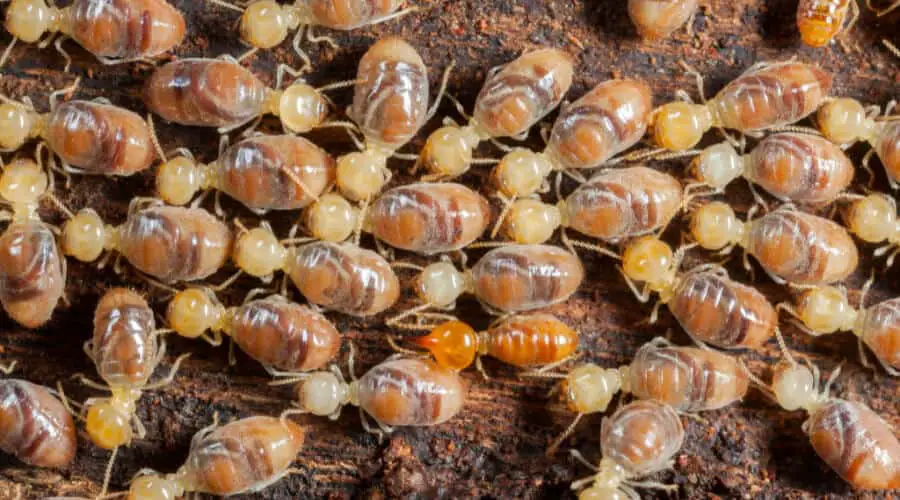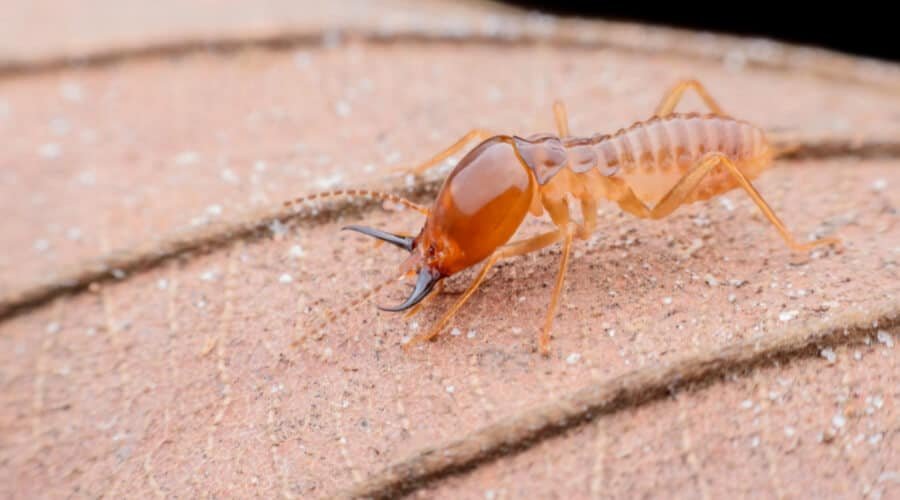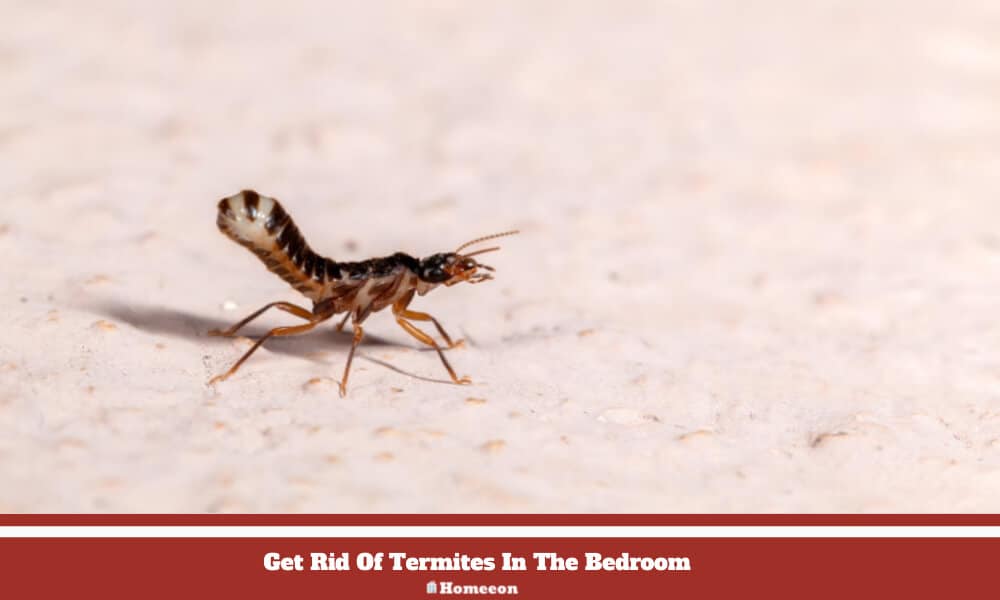Last Updated on July 25, 2023 By Emma W. Thomas
To eliminate termites in the bedroom, follow these steps:
- Identify termite-infested areas and signs of damage.
- Consult a professional pest control service for a thorough inspection.
- Implement appropriate treatment methods like termiticides or bait stations.
- Repair any termite-damaged structures promptly to prevent further infestations.
What Are The Different Types Of Termites?
There are two major types of termites primarily found in the US. They include;
Subterranean Termites

These are termites that live on foundational wood and compost piles in your bedroom. They travel around by creating mud tubes or highways, and they can generally do more damage than any other type of termite. These creatures are found countrywide with a narrow shape and about an eighth inch long.
Their status determines their color; hence they lack a specific one. For instance, workers have a pale cream color while soldiers are similar, with their heads brown. Primary reproducers are either black or brown, whereas supplementary reproducers are creamy white. Subterranean termites have enormous colonies, which could range from 100,00 termites to over a million.
Drywood Termites

Unlike the subterranean termites that require contact with soil for survival, dry wood termites live and depend on wood. They are usually found in warm places and are primarily white. There is also a group of winged dry wood termites, which are yellow-tan to light brown. These termites have small colonies which hold up to 2,500 members.
What Methods Can You Use To Remove Termites From Your Bedroom?
Before deciding on the method to use, you have to identify the type of termite you are dealing with. The following ways are effective;
By Applying Natural Termiticides
Unlike termiticide barriers, natural termite-killing chemicals can be used inside your bedroom. You apply it upon spotting a termite which helps to dispatch them immediately. You can use a spray bottle to apply the chemicals directly into the cracks, crevices, and voids. It produces an odorless foam that expands and evaporates, leaving a poisonous residue that kills the subterranean termites as soon as they get into contact. The best thing about this method is that the chemical can last for a month and sometimes even longer.
Using Spot Treatment
If the infected part is a painted or polished piece of wood, you drill the holes and fill them for treatment. At first, you drill about 10-inches holes into the wood where you hit their nest. You then fill up the gap with termiticide. To finish the spot treatment method, you add a wood patch to close up the crevices. In most cases, the procedure is applicable when dealing with dry wood termites.
Using Termite Baits
Termite baits are placed around your home’s perimeter. It acts by attracting termites to the traps containing poison. Most of these baits contain slow-acting toxins, which interrupt their natural growth causing their slow death. Due to the delayed functioning of the bait, infected termites end up carrying it back with them and transmit it to the rest of the colony.
By Using Termite Killing Barriers
Some states have professional-level termite-killing products available for purchase. You are required to apply these conventional termite killers on the exterior perimeter of your home to create a barrier. In this way, termites cannot detect the treatment making it impossible for them to avoid it. When they eat even a tiny bit of the termiticide material, they die since it spreads like a virus. The method is best used when dealing with subterranean termites.
Using Beneficial Nematodes
These are segmented microscopic roundworms. They are natural parasites that feed on many garden pests, including termites. Nematodes act by burrowing into their hosts and releasing some symbiotic gut bacteria, which poisons the termites’ blood causing their death after a few days. Beneficial nematodes are available in stores and also online. When using them, you apply a mixture of the nematodes in a pot of soil, and cold water, then apply it to the infected area of your bedroom.
Using Essential Oils
Neem and orange oils are the most commonly used oils to kill termites. They act by inhibiting their skin-shedding ability and laying eggs. To achieve this, you are required to mix two cups of water with a few drops of dish soap and ten drops of your preferred oil. Shake up the mixture and spray it on the infected area.
When uncertain of the termite type that has infested your room, you can go for a method that is likely to kill both types, for instance, spraying some boric acid into the infected part. It acts by dehydrating the termite, which cuts down its nervous system leading to its death. Alternatively, you can also go for the diatomaceous earth method, which kills them by penetrating their exoskeleton. It is made of fossilized aquatic organisms made from silica. When termites walk over the diatomaceous earth powder sprinkled on the ground, it is enough to cost them their life.
How Do You Identify A Termite Infestation In Your Bedroom?
It is challenging to spot termites skittering down your wooden areas. To determine if there is a possible termite infestation in your home, you will be required to check the attic and all cracks and crevices. Some of the most common signs of termites infestation include;
Presence Of Hollow Wood
You know there are dry wood termites in your wooden surfaces when you tap on them and hear a soft and hollow thud. To be specific, you can use a screwdriver to drill into the wood. In case of an infestation, the screwdriver will gain its way quickly, indicating the termites’ presence.
Mud Passageways
Subterranean termites create passageways made of mud to connect to wooden surfaces. These mud tubes are mostly made of soil and wood with the width of a pencil. When you come across such a passage tube, it is evidence of a possible termite infestation.
Headbanging
If you hear some strange clicking sound from inside your walls, it is usually a result of the soldier termites detecting a possible threat. Banging their heads against the walls is their mode of signaling the colony. Sometimes they give out the signal by shaking their bodies which produces sound.
Paint Peeling Off
When termites attack and damage drywall, they allow moisture to enter between the paint and the surface, making it peel off. There may be other reasons behind your drywall paint peeling. However, when it happens in tandem and is associated with different signs, it might indicate an infestation.
Visible Live Termites
It is essential to find out the difference between termites and flying ants to know what you are dealing with. Termites have even rear wings, a thick abdomen, and straight antennae. On the other side, flying ants have uneven wings, are thinner, and have bent antennae. When you see termites lingering around your room, there is likely an infestation.
How Do You Prevent Termite Infestation In Your Bedroom?
There are different ways you can use to make your bedroom less appealing to termites. They include;
Sealing Off Leaks
Subterranean termites highly depend on moisture for their survival. Keeping your room dry is one way to keep them away.
Filling Crevices And Cracks
Seal and caulk all unnecessary openings in your room where water pipes meet. You should also ensure to seal off the bedroom door and windows, which act as possible entry points for the termites.
Keeping The Pipes And Gutters Clean
Termites like hiding in warm, dark, and moist places, and pipes and gutters perfectly fit them. Clean the gutters and pipes regularly to prevent them from settling in.
Carry Out The Regular Inspection
It is said that prevention is better than cure. With regular checks from professional pest controllers, it is possible to avoid any form of termite infestation.
How Do You Kill Termites In Furniture?
Dealing with termites in furniture can be quite frustrating and involves a specific strategic process. The key to successfully dealing with this problem lies in early detection and proactive treatment. Below are some useful methods you can employ to kill termites in your furniture:
- Heat Treatment
Heat Treatment involves exposing the furniture to high temperatures. Termites cannot survive in temperatures above 120°F or below -20°F. This method is environmentally friendly and doesn’t require any chemicals. Make sure the furniture is heat-treated for at least 2 to 5 hours. - Use of Pesticides
Various liquid pesticides, also referred to as termicides, are available in the market that can kill termites effectively. Make sure to read the instructions and safety precautions before using any pesticide to eliminate termites. Small applications at detected termite spots can greatly reduce their population. - Boric Acid Treatment
One of the most effective natural remedies is using boric acid. This acid damages the nervous system of the termites, subsequently killing them. Spray or apply a boric acid solution to the affected parts of the furniture. - Cardboard Traps
Cardboards are effective termite traps due to their cellulose content that attracts termites. Wet the cardboard, place it near the affected furniture, and once it is infested with termites, burn it outside in a safe environment. - Use of Nematodes
Nematodes, or parasitic roundworms, are natural parasites to garden pests, including termites. Apply them in and around the infested furniture. Nematodes feed on termites and thus, help in controlling their population. - Professional Fumigation
If the infestation is severe, it might be necessary to hire professional pest control services for fumigation. This method involves enclosing the furniture in a sealed environment, then introducing a deadly gas.
How To Differentiate Active From Non-Active Termites’ Infestation?
| Active termite infestation | Non-active termites infestation |
| Presence of mud tubes around the infested area, such as floor joists and pillars | Mud tubes are usually empty and no longer transport the termites to your room. |
| There are swarms of termites around your home or inside the house | There are only a few termites found outside your home |
| Seeing the actual termites in the room | There are no on sight termites |
| There are swarms of termites around your home or inside the house | There are only a few termites found outside your home |
| Presence of frass and feces spots on wooden areas | No feces or frass found in your room |
How to Choose a Pest Control Service
1. Research and Verify Credentials
Before hiring a pest control service, it’s crucial to research and verify their credentials. Look for companies that are licensed and insured. Check if they have professional certifications, such as a QualityPro or GreenPro certification, which indicates a commitment to environmentally friendly and effective pest control practices.
2. Experience and Expertise
Choose a pest control service with substantial experience in the industry. Experienced professionals possess the knowledge and skills required to effectively identify pests, assess infestation severity, and apply appropriate treatment methods. They are more likely to have encountered a variety of pest control scenarios, making them better equipped to handle your specific situation.
3. Reputation and Reviews
Don’t underestimate the power of customer reviews and testimonials. Check online platforms, such as review websites, social media, and forums, to gauge the reputation of the pest control service you are considering. Read both positive and negative experiences shared by previous customers. Pay attention to recurring themes or issues and consider how the company responds to feedback.
4. Methods and Products
Choose a pest control service that utilizes safe and effective methods and products. Inquire about the techniques they use to control pests and whether they prioritize eco-friendly solutions. Reputable companies will be transparent about the chemicals they use and their potential impact on people, pets, and the environment. Opting for a service that incorporates integrated pest management (IPM) practices is a wise choice.
5. Guarantees and Warranties
It’s important to find a pest control service that offers guarantees and warranties. A company that stands behind its work will provide reassurance that they are committed to solving your pest problems. Ask about their policies regarding follow-up visits and how they handle situations where the treatment doesn’t produce the desired results.
6. Pricing and Affordability
While price shouldn’t be the sole determining factor, it is important to consider your budget. Obtain estimates from multiple pest control services and compare their pricing structures. However, be wary of extremely low prices, as they may indicate subpar service or the use of inferior products. Look for a balance between affordability and the quality of service provided.
7. Insurance Coverage
Before finalizing your decision, ensure that the pest control service has appropriate insurance coverage. Liability insurance protects you and your property in case of any accidental damage that may occur during the treatment process. Workers’ compensation insurance, on the other hand, covers potential injuries sustained by the technicians while on your property.
8. Customer Service
Consider the level of customer service provided by the pest control service. Are they prompt in responding to inquiries and providing information? Do they educate customers about the pests they are dealing with and offer prevention tips? A company that values customer satisfaction and offers exceptional service is more likely to go the extra mile to meet your needs.
9. Timeliness and Flexibility
Pests can multiply rapidly, causing greater damage over time. Therefore, opt for a pest control service that can promptly schedule an inspection and treatment. Additionally, inquire about their availability for emergency situations. A service that can accommodate your schedule and offers timely assistance will help prevent pest infestations from worsening.
10. Seek Recommendations
Lastly, seek recommendations from friends, family, or neighbors who have dealt with similar pest issues. Personal referrals can provide valuable insights and first-hand experiences that can steer you toward a reliable and trustworthy pest control service.
Conclusion
To get rid of termites, you can either do it yourself or have a professional insect terminator do the job for you. Before terminating them, you are required to identify the type of termites you are dealing with to decide on the best method to apply. Some methods, such as using the boric acid spray, can get kill both types. Another way is by using diatomaceous earth and cardboard traps. You can also go for methods that target specific termite types, whether drywood or subterranean.
References:
https://www.thisoldhouse.com/pest-control/reviews/how-to-get-rid-of-termites
https://mast-producing-trees.org/how-to-remove-termites-from-your-bed-a-comprehensive-guide/
Emma is a graduate of Domestic Science or Family and Consumer Sciences (Home Economics) from the University of Wisconsin. She has 7 years of experience Working with the strategic section of BestBuy and now writing full-time for Homeeon.
From Managing the Home, Interiors, Cleaning, and Exteriors to Gardening and everything about Making A Home Liveable – is her passion and this Homeeon is the result of this.
Emma loves decorating her home with the best stuff found online. She cares about quality over anything and writes reviews about them here in Homeeon. Get in touch with her over Pinterest.
Keep reading her blogs.

